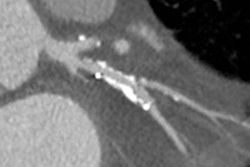Coronary CT angiography (CCTA) is highly accurate for diagnosing the most dangerous forms of coronary artery disease -- left main artery disease or three-vessel disease -- but the examination significantly overcalls the extent of atherosclerosis compared with angiography, Dutch researchers reported at RSNA 2012.
The retrospective study of more than 1,000 patients found CT was 95% sensitive for the detection of left main or three-vessel disease, but severity of disease was overestimated in nearly half of the cases, said Dr. Anoeshka Dharampal from Erasmus University Medical Center in Rotterdam, the Netherlands.
"It's important to identify if left main [LM] coronary artery disease or three-vessel disease [3VD] is present because earlier studies have shown that revascularization in these patients significantly improves prognosis," Dharampal said. "In our study we wanted to evaluate the diagnostic performance of CCTA in symptomatic patients with suspected coronary artery disease, especially looking at high-risk coronary artery disease, and then compare [the results] to angiography."
In all, the researchers examined 1,124 symptomatic patients with stable angina and without prior revascularization (69% men, 61±11 years). All patients had undergone a clinical exam, invasive coronary angiography, and CCTA between 2004 and 2010. Most scans were performed on 64-detector-row scanners, with increasing numbers of CCTA exams performed on 128-detector-row dual-source CT scanners toward the end of the study period, she said. Noncontrast-enhanced calcium scoring CT was performed before each CCTA exam.
Vessels were considered obstructive when the stenosis occupied 50% or more of the vessel lumen. The researchers compared the diagnostic performance of CCTA to detect LM and/or 3VD versus angiography, calculating sensitivity, specificity, positive and negative predictive values. The study team also looked at the area under the ROC curve for CCTA's discrimination of high-risk coronary artery disease and the correlation of CCTA, invasive angiography, and Duke risk score.
The mean Duke risk score in the cohort was 71% and the mean calcium score was 230. The prevalence of high-risk coronary artery disease, e.g. left main artery and/or three-vessel disease, was 17% (n = 56), Dharampal noted.
CCTA's sensitivity for the detection of LM and/or three-vessel disease was 95% (95% CI: 91%-97%); the specificity was 83% (81%-86%); the positive predictive value was 54% (95% CI: 49%-59%) and the negative predictive value was 99% (95% CI: 98%-99%) with an area under the receiver operating characteristic curve of 0.91 (95% CI: 0.88-0.93).
CCTA results yielded 774 true negative lesions, 10 false-negatives, 156 false-positives, and 184 true positives, she said. Of the 56 patients with high-risk disease diagnosed by CCTA, 26 were overdiagnosed according to coronary angiography, she said. The number of false-positive results was relatively high due to the overestimation of severity of stenosis.
"Although CCTA had a sensitivity of 95% for the detection of high-risk coronary artery disease, specificity was slightly lower at 83%," Dharampal said. "When CCTA detects high-risk coronary artery disease, in 56% of the cases it is correct, and in 46% it is an overdiagnosis. When CTCA excludes high-risk coronary artery disease it is correct in 99% of the cases." As would be expected, combining risk scores, angiography, and CCTA boosts the accuracy of the results, she said.
Responding to a question from the audience, Dharampal said she couldn't explain the false-negative CCTA results in 10 patients. Studies were not excluded due to poor image quality, but that would tend to produce motion artifacts and false-positive results, she said.



















